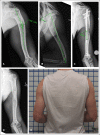Limb Length Discrepancy and Angular Deformity due to Benign Bone Tumors and Tumor-like Lesions
- PMID: 33720060
- PMCID: PMC7954373
- DOI: 10.5435/JAAOSGlobal-D-20-00214
Limb Length Discrepancy and Angular Deformity due to Benign Bone Tumors and Tumor-like Lesions
Abstract
Benign bone tumors and tumor-like lesions are frequently diagnosed in children and adolescents. The immature skeleton is at risk for growth disturbances and deformity because of the effects of the lesions on normal bone architecture and the physis. The development, manifestation, and severity of the limb length inequality and deformity differs between the various bone pathologies. Distraction osteogenesis, osteotomy, and guided growth are key tools in the treatment of limb inequality and deformity using a combination of external and internal fixation devices.
Copyright © 2021 The Authors. Published by Wolters Kluwer Health, Inc. on behalf of the American Academy of Orthopaedic Surgeons.
Figures





Similar articles
-
[Physeal distraction for limb length discrepancy and angular deformity].Rev Chir Orthop Reparatrice Appar Mot. 2005 May;91(3):199-207. doi: 10.1016/s0035-1040(05)84305-3. Rev Chir Orthop Reparatrice Appar Mot. 2005. PMID: 15976663 French.
-
Distraction osteogenesis of the femur using conventional monolateral external fixator.Arch Orthop Trauma Surg. 2008 Sep;128(9):889-99. doi: 10.1007/s00402-007-0437-1. Epub 2007 Sep 15. Arch Orthop Trauma Surg. 2008. PMID: 17874249
-
Correction of deformity and shortening due to post traumatic epiphyseal arrest by distraction osteogenesis.Arch Orthop Trauma Surg. 2007 Oct;127(8):659-63. doi: 10.1007/s00402-007-0339-2. Epub 2007 Jul 20. Arch Orthop Trauma Surg. 2007. PMID: 17641907
-
Advances in management of limb length discrepancy and lower limb deformity.Curr Opin Pediatr. 2008 Feb;20(1):46-51. doi: 10.1097/MOP.0b013e3282f35eeb. Curr Opin Pediatr. 2008. PMID: 18197038 Review.
-
[Lengthening of lower limbs--implantable therapeutic devices in distraction osteogenesis].Duodecim. 2010;126(1):55-63. Duodecim. 2010. PMID: 20405609 Review. Finnish.
Cited by
-
How do lesions affect limb lengthening in children with Ollier's disease?BMC Musculoskelet Disord. 2025 Jan 3;26(1):13. doi: 10.1186/s12891-024-08261-9. BMC Musculoskelet Disord. 2025. PMID: 39754076 Free PMC article.
-
Lateral Gradual Opening Osteotomy of the Tibia With Monolateral External Fixator for Correcting the Valgus Deformity of the Tibia.Arthrosc Tech. 2022 Nov 18;11(12):e2271-e2277. doi: 10.1016/j.eats.2022.08.036. eCollection 2022 Dec. Arthrosc Tech. 2022. PMID: 36632387 Free PMC article.
-
New bone formation accelerates during lower limb lengthening and deformity correction in children with Ollier's disease.J Orthop Traumatol. 2023 Jul 31;24(1):39. doi: 10.1186/s10195-023-00717-3. J Orthop Traumatol. 2023. PMID: 37524995 Free PMC article.
-
Simple bone cysts of the proximal humerus presented with limb length discrepancy: A case report.World J Clin Cases. 2024 Feb 26;12(6):1130-1137. doi: 10.12998/wjcc.v12.i6.1130. World J Clin Cases. 2024. PMID: 38464921 Free PMC article.
References
MeSH terms
LinkOut - more resources
Full Text Sources
Other Literature Sources
Medical

